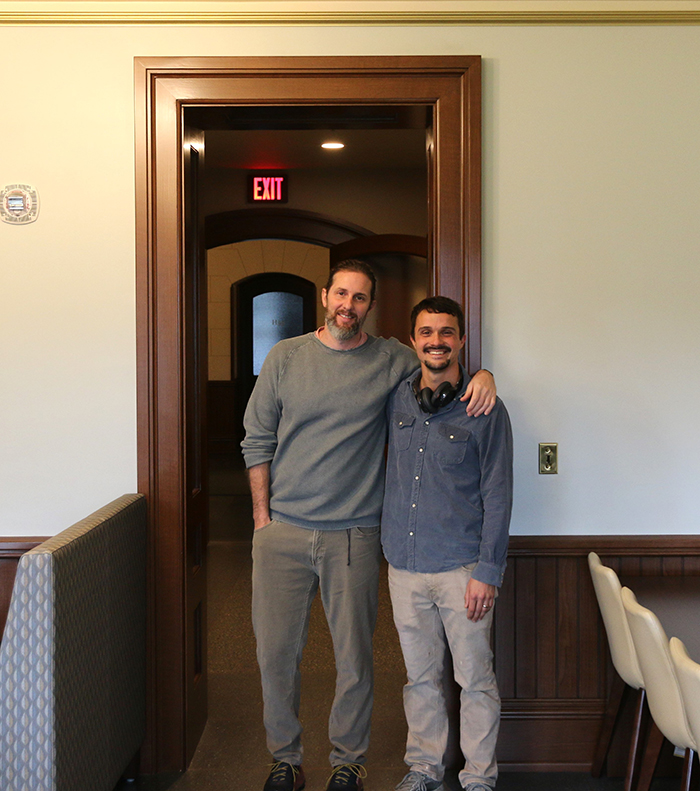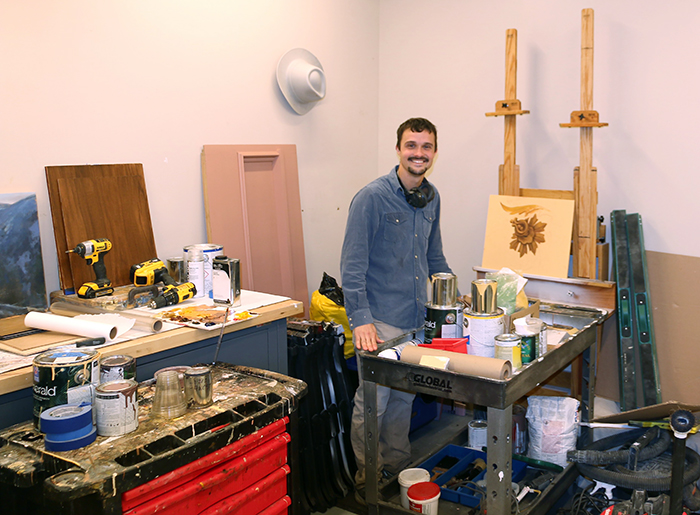
Kendall College of Art and Design of Ferris State University alums Josh Risner, left,
and Anthony Cairo in the Capitol in front of a wood-trimmed doorframe meticulously
painted to look like walnut.
LANSING, Mich. – Each year, hundreds of thousands of visitors to the Capitol Building in Lansing walk along ornate hallways on beautifully tiled, checkerboard floors surrounded by intricate designs on the walls, impressive marble columns and dark walnut wainscotting and doorways.
But for Kendall College of Art and Design of Ferris State University graduates Anthony Cairo and Josh Risner the hallways and offices and conference rooms, and even the House and Senate chambers, are a canvas. And the two consider themselves part of a long tradition of what might be called artistic alchemy.
“Visitors often treat us like magicians,” Risner said with a wide, eyes-sparkling smile. “It feels pretty good.”
That’s because at the Capitol, some things are not what they appear to be.
The beautiful walnut wainscotting and trim is actually plain old pine, transformed to look like walnut via a painstaking painting process that dates back to the building’s origins in the late 1800s. And the marble is painted cast iron, also transformed by hand via intricate processes and paints and pigments to look like something it is not.
Risner and Cairo said that when the Capitol was built (as Michigan’s third Capitol building) it was common practice to take inexpensive materials like pine, plaster, pressed tin and cast iron and paint them to look like marble and walnut.
As a Capitol visitor’s guide notes “nine acres of walls, ceilings, woodwork and columns were painted by hand, using brilliant colors, elaborate patterns and every skill of the painter’s art. Today, with every inch carefully restored, the deception is so successful that few visitors realize that our marble columns are really painted cast iron and our walnut woodwork is really painted pine. The Michigan State Capitol stands today as one of the country’s best examples of the painted decorative arts of the Victorian era.”
Maintaining the century-old illusion is now the purview of Cairo and Risner, who met during their time together at Kendall.

Kendall College of Art and Design of Ferris State University alum Anthony Cairo is
pictured in his workshop at the Capitol, surrounded by the tools of his trade.
Risner was hired as the Capitol's master decorative painter in January 2016 and brought Cairo on as an apprentice before handing the reins to Cairo and becoming a consultant to advise and help with any artistic endeavor at the Capitol. He also reproduces lost portraits of Governors and oversees the conservation of paintings in the Capitol.
Cairo is a full-time state employee and works for the Michigan State Capitol Commission, restoring faux finishes, decorative designs and stencils, surface-cleaning paintings in the Capitol collection, doing small touch-ups throughout the building (some of which can take months) and more.
The Capitol is currently undergoing a significant renovation project to the dome and another ongoing project is addressing behind-the-scenes issues like wiring and pipes.
What’s behind the walls and ceilings often impacts what’s on the walls and ceilings.
Leaks are a particular bane for Cairo. A recent project on a wall near a restroom and an elevator saw cracked plaster and other damage that required him to patch the plaster, match paint and hand draw an intricate design on the wall. When it was complete, he said, nobody would ever know the extent of the damage.
“Plaster patchwork is absolutely an art,” he said. “So is color matching and paint making. For this repair, copying the design was the easy part. In fact, this wall had an organic, bumpy texture I had to match, so I made my own gesso with marble dust mixed with sand to create a surface texture that bonded with the wall repair.”
Cairo said that while he didn’t learn such techniques at Kendall, he did develop a foundational knowledge there that still informs his daily work at the Capitol. And in college, he learned how to learn, something that continues to this day.
“I have freedom and time to explore processes, materials and techniques that have improved my capabilities as an artist significantly,” he said. “And being surrounded by incredible paintings and decorative art daily has helped maintain my vision as an artist.”
Both Risner and Cairo said they never imagined careers of this sort as Kendall students.
Cairo grew up in Shelby Township and said he had a wonderful art teacher in high school who encouraged students to pursue their passions. He was attracted to Kendall for the drawing program, which was a focus for him at the time.
He still recalls fondly the influence of former faculty members Jon McDonald for illustration and Gypsy Schindler for drawing.
“I learned a great deal about color from Jon and how to approach drawing with unique expression from Gypsy,” he said.
Cairo also worked on the college’s facilities team, spending evenings cleaning to cover the costs for tuition and rent. Through the job, he met Risner, a graduate student at the time, and the two clicked.
Risner came to Kendall from Ashland, Ohio, drawn to the college by its creative resources and a full scholarship.
“I did receive a full ride to another school and several half-tuition scholarships, but Kendall had the best location and the best facilities,” he recalled. “And ultimately Kendall helped me refine my artistic thinking through a focus on art history, critical thought and postmodern philosophy.”
He smiled as he recalled his journey as an artist.
“I originally thought I would teach graphic design at the college level,” he said. “That turned into teaching painting and eventually into not teaching at all. I had no idea that I would be doing what I am doing now. I have been involved in so many different projects at the Capitol over the last eight years it feels like a lifetime of cool experiences.”
Cairo echoed those remarks.
“As a Kendall student, all the artists I knew were professors or teachers,” he said. “I thought that was the only path for an artist in today’s world, so I imagined myself doing the same thing. I could never have planned this career, but working at the Capitol has expanded my technical capabilities, material knowledge and understanding of traditional art in a profound way.”
In addition to their own work hanging in various places throughout the Capitol (something both artists said is a thrill), Risner also did one of the Governor portraits that line the walls of the Rotunda, a large painting of former Gov. Rick Snyder standing outside with an inland lake in the background, surrounded by leaves and autumn beauty.
“Many of the artists who have paintings in the Capitol are nationally known, have painted presidents and popes and have studied with some of the greatest artists of all time,” said Risner. “I’m happy to be associated with its history and all the other artists that have made their mark on the Capitol.”
Cairo said the same.
“When I see the paintings Josh and I have hanging in the building, it feels surreal at times,” he said.
Both men consider their surroundings a huge bonus when it comes to workplaces.
Cairo is well known by not just Capitol staff but also by senators and representatives, Risner said.
“He’s a little bit of a star around here,” he added with a grin.
For his part, Risner said, it’s hard to beat the Capitol as a workplace.
“I still like roaming the halls and seeing the amazement on people's faces as they look around in awe,” he said simply.
This story was reported by Phil de Haan for Ferris State University.

